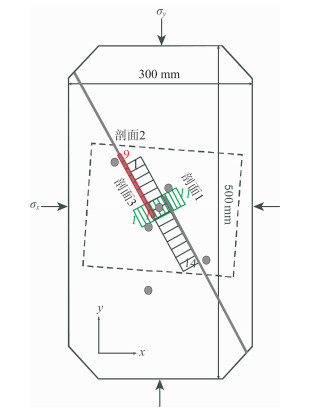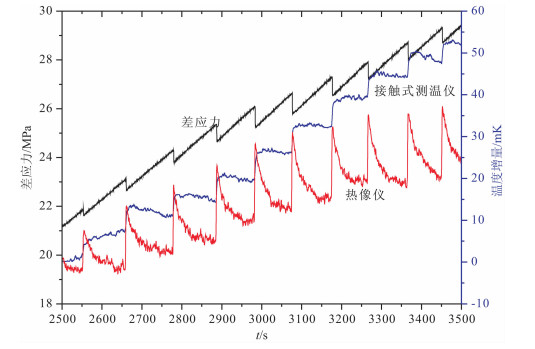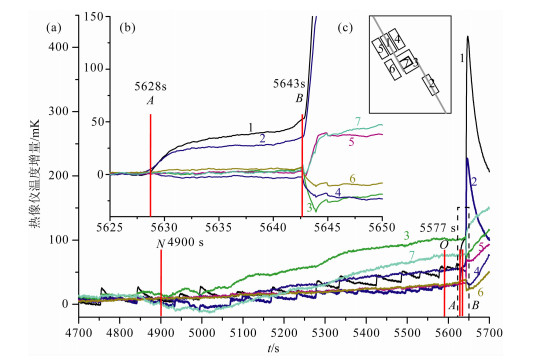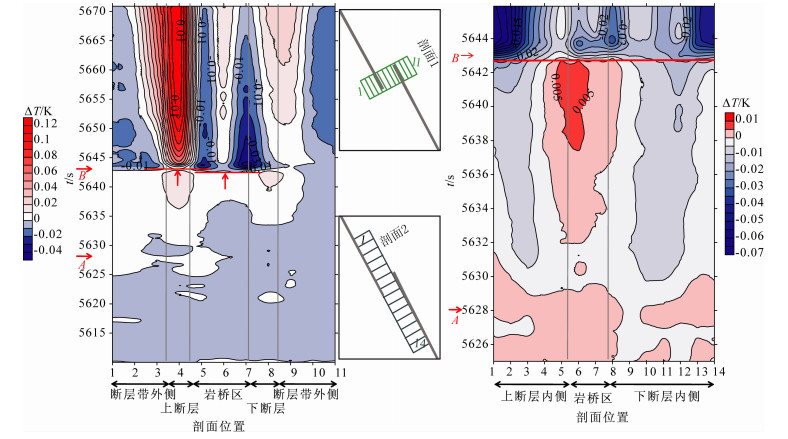近年来,许多学者根据深井水温、浅层地温、气温及遥感热红外信息的观测,尝试寻找与地震及断层现今构造活动相关的热异常[1-11].由于地壳岩石中温度扩散衰减很快,通过这些观测手段基于热传导获取来自数公里深震源区的温度异常是不可行的.因此一些学者提出新的假说,如由于地壳突发性放气和低空静电场突变作用引起低空大气热红外增温的“地球放气说”[12]、震前活动断层及裂隙处释放的氡与大气层中各种气体反应从而使空气温度升高的“LAIC模型”[13]及地表变形说[14]等.而本文侧重点是基于地表形变引起的温度变化.
众所周知断层摩擦引起升温,但对岩石变形过程的温度变化,尤其是弹性变形的温度变化研究很少.一般弹性力学侧重研究等温过程的弹性变形,在等温条件下弹性变形服从胡克定律,即dσ=Edε, 其中σ为应力,ε为应变,E为弹性模量.实际上在绝热过程,受热膨胀的材料也会受压升温.绝热条件下固体弹性变形的状态方程不再是胡克定律,而变为:dσ=Edε + βdT,其中β为热应力系数•此状态方程经常用来研究热胀冷缩引起的应力问题,但涉及应力引起温度变化的研究很少.
一些学者开展了岩石变形过程温度变化的实验研究[15-22],获得了许多宝贵的实验成果.实验中通常采用红外热成像系统进行温度场的测量,但由于红外系统温度测量精度较低,而岩石弹性变形过程中的温度变化较小,不同学者得到的结论有些有较大的差距.作者所在实验室为了研究热与应变的关系建立了一套温度观测系统[23].该系统可以利用接触式温度测量系统和远红外热像连续观测系统共同观测不同变形条件下变形体不同部位的温度变化过程.利用这个实验系统,主要从以下两方面开展工作:其一,从变形和温度响应的物理关系出发,阐明了在绝热环境下,对于可逆过程(弹性变形过程),岩石等受热膨胀的材料(其热应力系数为正)受挤压时,加载升温;卸载降温,对于绝热不可逆过程(塑性变形、损伤和摩擦),岩石温度升高[14, 24],也就是存在应变升温和摩擦升温两类机制;其二,研究典型构造几何模型变形过程中的热场变化,证明了热场与应变场密切相关[25-27],通过对比压性岩桥区和张性岩桥区的变形对温度的响应,进一步证明这些部位的温度变化是由体积应变引起,可以利用不同构造部位的温度变化判断断层的错动,研究强调了岩桥区的降温和断层带的升温以及升温脉冲等是断层失稳的前兆.
大量实验证明,在应力应变曲线上位于应力峰值点和快速失稳点之间,存在一个亚失稳阶段[28].亚失稳阶段是岩石变形失稳前的最后阶段,也是地震短临预报的关键阶段.研究这个变形阶段各种物理场的演化特点对于判断失稳至关重要.以往的一些研究中泛指失稳前的变化为前兆,很难利用观测到的现象预测失稳时刻.为此,利用实验室易于在应力应变曲线上识别亚失稳阶段的有利条件,使用新购进的红外观测系统识别亚失稳阶段的热场特点,对于地震前兆探索研究十分重要.
雁列断层是野外常见的地质构造,前人已开展过较多基础性研究[29-31].雁列断层在变形过程中在不同的构造部位有着不同的温度变化特点和机理[25-27, 32].本文重点探讨压性雁列断层在亚失稳阶段的热场演化特点.

|
图 1 标本结构及研究区 灰色粗实线为预制断层,虚线框为热像观测区域,灰色实心圆为接触式测温仪探头所在位置,绿色、黑色及红色条形框区域分别为剖面1、2、3. Fig. 1 Specimen structure and study area Gray thick solid line is precut fault, the dashed line is observation range, gray solid circle s location of contact-type thermometer, green, black and red areas are profile 1, 2, 3. |
观测以红外热像仪为主,还布设了少量接触式测温仪测点, 实验标本为500 mm × 300 mm × 50 mm的房山花岗闪长岩.在标本上预制雁列切口,切口与轴向夹角31°两条雁列断层间的垂直距离为35 mm,两断层在雁列部位重叠,重叠距离为29 mm (图 1),断层段充填石膏.图 1中虚线勾画的矩形区为热像观测区.
红外热像仪的基本参数:光谱范围8~12 μm,AD转换14bit,测温范围设定为0~40 ℃时,AD转换的最小温度分辨率2. 5 mK,噪声等效温差25 mK,空间分辨率640 × 512像素,本次实验每个像素对应于实际尺寸的0. 35 mm,实验中热像采集频率为10帧/s.
利用双向伺服压机对标本加载,首先在x和y方向同时加载至5 MPa,然后令x方向的载荷保持常数,y方向按位移控制方式加载,位移速率保持常数0.5 μm/s.加载时右侧和下方固定,左侧和上方滑动,上断层是主动端,图 2b表示实验过程中差应力的变化,本文重点讨论失稳前的变化过程(图 2b中用黑色虚线框标出的时段),图 2a中曲线为该时段的差应力时间曲线放大图.

|
图 2 差应力随时间的变化(图 2a是图 2b中虚线框的放大图) Fig. 2 Variation of differential-stress with time (Fig.2a is the enlarged figure of the dotted area in Fig.2b) |
差应力与两种测温结果(红外热像仪、接触式测温仪)的关系可从图 3中看出:温度变化对应应力状态改变; 两种测温结果趋势一致,但热像仪不受传感器热惯量的影响,对温度变化响应迅速,温度变化幅度大于接触式测温仪,且黏滑时温度呈尖峰状.

|
图 3 温度与差应力随时间的变化 红色和蓝色曲线分别表示红外热像仪和接触式测温仪的测温结果. Fig. 3 Variation of temperature and differential stress with time Red and blue curvesrepresent temperature results of infrared thermal image and contact-type thermometer respectively. |
由于应变引起的温度变化量级较小,以及样本本底的不均匀和环境噪声的影响,难以从热像上直接看到温度的细微变化,需要对数据进一步处理.本文通过区域平均和滑动平均减弱随机噪声,也就是减小空间分辨率和时间分辨率换取温度测量精度,即降低噪声等效温差.
3 实验结果 3.1 破裂失稳阶段的划分以N点为分界点,变形包含应力积累和破裂失稳两个阶段,应力积累阶段伴随小黏滑事件(图 2b).本次研究着重分析破裂失稳阶段(图 2a).图 2b显示在N点(第4900 s)出现了强烈的偏离线性现象,图 2a显示N点后差应力仍以较低速率增加,到第5577.2 s达到峰值点O.O之后差应力以较慢速率下降,处于应力相持阶段.到5628 s达到转折点A.A点后差应力加速释放,2~3 s后释放速率变小.十多秒后到达失稳点B,即第5643.12 s,释放速率迅速增大,发生失稳错动.这一过程可由N、O、A、B划分为四个阶段:NO称之为“强偏离线性阶段”,OA称之为“亚失稳阶段Ⅰ”,AB称之为“亚失稳阶段Ⅱ”,B之后是“失稳阶段”.
3.2 不同构造部位温度随时间的变化图 4中曲线1-7表示不同构造部位温度平均值随时间的变化,图 4b是图 4a中虚线框的放大图,图 4c是构造部位分布图d、2位于上断层和下断层,3和7是岩桥区外围和中心,4位于断层带内侧,5、是断层带外侧.

|
图 4 不同构造部位的平均温度随时间的变化 图 4b是图 4a中虚线框的放大图, 图 4a (图 4b)纵轴是温度相对于4500s (5620s)的增量; (c)构造部位分布图. Fig. 4 Variation of average temperature in different tectonic positions with time Fig.4a is the enlarged figure of the dotted area in Fig.4b; the vertical axis value is an incremental temperature versus 4500s (5620s) in Fig.4a(Fig.4b); Fig.4c is the sketch map of tectonic positions. |
图 4a及图 4b显示,O、A、B三点,温度状态明显改变O点时,岩桥区增温接近峰值点,之后尽管有波动,但变化幅度较小; A点时,断层带加速升温;B点时,断层带温度突升,断层外侧(区域5)和岩桥区中心(区域7)温度先降后升,岩桥区周围(区域3、6)及断层带内侧(区域4)则是较大幅度降温.
热像增量图更直观地表现出温度的时空变化.强偏离线性阶段(图 5a),岩桥区中心增温显著,约为134 mK,平均升温速率约为0. 23 mK/s; 亚失稳阶段I后期(图 5b)增温区逐渐转移到断层带,最高增温幅度达18mK,平均升温速率为0. 38mK/s; 亚失稳阶段n后期(图 5c),断层带增温更明显,且高温点增多,断层带内侧出现降温;破裂失稳瞬间(图 4d),只有断层区域升温,高达130 mK,平均升温速率65mK/s, 样本整体降温20~40mK, 平均降温速率为10~20 mK/s,降温以岩桥区和断层带内侧最为明显.失稳瞬间降温在以往的实验中观测得并不十分明显.

|
图 5 不同阶段的热像增量 (a)强偏离线性阶段岩桥区增温现象; (b)亚失稳阶段Ⅰ后期断层增温现象; (c)亚失稳阶段Ⅱ后期断层增温及断层内侧降温现象; (d)失稳阶段样本整体降温及断层增温现象.图 5a为第5577s减去第4997s的增量, 图 5b为第5625s减去第5577s的增量, 图 5c为第5641s减去第5625s的增量, 图 5d为第5643.91s减去第5641s的增量. Fig. 5 Temperature increment of different stages (a) Temperature increase in the jog area in stage of strongly-deviation-from-linearity; (b) Temperature increase infault zones in late stage of meta-instability Ⅰ; (c) Temperature in crease in fault zones and temperature decrease in between the faults in late stage of meta-instability Ⅱ; (d) Temperature decrease of the whole sample and temperature increase in fault zones in stage of instability. Fig.5a is an increment of 5577 s subtracting 4997 s, Fig.5b is an increment of 5625 s subtracting 5577s, Fig.5c is an increment of 5641 s subtracting 5625 s, and Fig.5d is an increment of 5643.91 s subtracting 5641s. |
Y向轴压持续增大,岩桥区处于挤压状态.强偏离线性阶段,应力高度集中于岩桥区,升温显著;亚失稳阶段I,断层局部错动,断层带摩擦增温;亚失稳阶段n,岩桥区破裂,为断层错动提供条件,导致断层带内侧卸载降温,断层带错动范围扩展,增温范围扩大; 失稳错动阶段,断层滑动,整体应力释放,断层带由于摩擦生热,而岩桥区和断层带内侧在失稳前承受了较大的应力,失稳瞬间应力降较大,成为降温中心.
3.3 各剖面温度随时间的变化图 6a为剖面1温度随时间的变化(横坐标是剖面位置,纵坐标是时间.剖面1垂直于断层,位置见图 6b上图.位置4, 8为断层,5、6、7是岩桥区).A点前,温度随机变化.A点后,断层开始增温.临近B点时,岩桥区先降温,随即断层带迅速增温,发生错动.降温意味着岩桥区贯通,而岩桥区的贯通为断层错动提供了条件.断层带增温和岩桥区降温是亚失稳阶段的重要特点.

|
图 6 垂直断层方向(剖面1)和平行断层方向(剖面2)温度随时间的变化 (a)垂直断层方向(剖面1)温度随时间的变化; (b)剖面位置示意图; (c)平行断层方向(剖面2)温度随时间的变化.(a)和(c)中以黑色虚线分隔剖面位置, (a)中红色直线及箭头处表明岩桥区降温早于断层带强烈升温; (c)中红色实线处表明在失稳前整个剖面出现协同化降温; (b)是剖面位置示意. Fig. 6 Temperature variations of profiles vertical to thefault (profile 1) and parallel to the fault (profile 2) with time (a) Temperature variations of profiles vertical to the fault (profile 1) with time; (b) The sketch map of position of profiles; (c) Temperature variations of profile parallel to the fault (profile 2) with time. Black dotted line in Fig.6a and Fig.6c for separating the locations of the profile; red solid line and arrow show temperature decrease in jog area occurred earlier than strong increase in fault zones in Fig.6a; red solid line show synergy of temperature decrease of the whole profile before instability in Fig.6c; Fig.6b is the sketch map of the profile positions. |
图 6c为剖面2温度随时间的变化(剖面位置见图 6b下图,位置1~5及8~14为断层内侧,6~7为岩桥区).A点之后,不同位置温度出现分异,断层内侧降温,上断层内侧与岩桥区的分界处增温,可能与裂纹扩展处应力集中有关,在文献[15]曾描述过此现象.A点后出现两次重要降温,第一次发生在失稳前约14 s,降温只在断层内侧;临近失稳大约0.4 s时(图 6c上端红线所示),整个剖面温度变化趋向一致,出现协同化降温.亚失稳阶段的这两个降温现象是失稳前非常重要的信号.
图 7a和图 7c为不同时段剖面3(图 7b上图),即沿上断层不同位置温度随时间的变化.图 7a显示断层在5340 s就出现相对高温点.5430 s时在热像图上已可分辨(图 7b上图),亚失稳阶段(5603 s)更加清晰(图 7b下图).A点之后,整条断层加速升温,出现协同化增温(图 7a).与上述失稳前协同化降温(图 6c)不同,协同化增温出现较早,且只发生在断层上.选择峰值点O后包括失稳在内的时段作进一步分析发现,上断层段在失稳前24、14、10s出现三次阶梯式升温(图 7c),高温范围集中在靠近岩桥区的端点处,这也是亚失稳阶段的重要热场标志.

|
图 7 不同阶段沿上断层(剖面3)温度随时间的变化及热像图 (a)强偏离线性阶段-亚失稳阶段; (b)热像图及剖面位置示意; (c)亚失稳阶段-失稳阶段.图 7b红色箭头示意温度变化特殊位置, 图 7c红色括号及数字表示亚失稳阶段断层上三次阶梯式升温. Fig. 7 Temperature variations of profile along the fault (profile 3) in different stages and the thermal images with time (a) Strongly-deviation-from-linearity stage to meta-instability stage; (b) Thermal images and the sketch map of position of profile 3;(c) Meta-instability stage to instability stage. Red arrow show locations of special temperature changes in Fig.7a; red braces and numbers show three stepped temperature increase in the fault zones during stage of meta-instability in Fig.7c. |
热像图上也可直接观测到断层失稳错动过程(图 8久第5643. 12 s (B时刻),断层温度整体上升,上断层端点处的高温点相比5603 s时(图 6b下)减弱;第5643. 21 s, 高温点出现在上、下断层;第5643. 31 s,上、下断层高温部位同时扩展并增强;第5644. 92 s, 断层温度升至最高,上断层311mK,下断层162mK.对比图 8a和图 8(b,c)可明显看到后期低温区域增大.样本整体降温标志着大范围的应力释放.

|
图 8 失稳阶段不同瞬间热像图 Fig. 8 Thermal images of different moment during instability stage |
根据应力时间曲线,破裂失稳过程可分为强偏离线性阶段、亚失稳阶段和失稳阶段.本文讨论了各个阶段的热场变化:
(1) 强偏离线性阶段,应变主要集中在岩桥区,岩桥区明显增温(图 5a),同时断层由于局部错动开始出现高温点(图 7a).
(2) 亚失稳阶段,亚失稳阶段I,增温区逐渐转移到断层带(图 5b),高温点更加明显(图 7b下);亚失稳阶段n,断层带错动范围扩大,增温从局部向整体转变(图 5c),断层带内侧卸载降温(图 5c),临近失稳时,断层带协同化增温(图 7a),岩桥区及断层带内侧协同化降温(图 6c).
(3) 失稳阶段,应力释放,样本整体卸载降温,只有断层带因摩擦增温(图 5d).与此同时,热像图上可看到上下断层段的呼应与相互作用以及断层以外降温区的扩大(图 8).
总之,不同变形阶段,不同构造部位,标本的温度变化不同.可根据温度变化特点识别样本所处的变形阶段.断层带加速增温(图 7c)及断层带内侧降温(图 5c、图 6c)是识别亚失稳态的重要热场标志;断层带协同化增温(图 7a)和断层带内侧及岩桥区协同化降温(图 6c)是即将失稳的重要信号.根据热场的变化推断断层错动并非从一点开始整体滑动,而是多点错动,逐步扩展连接,最终出现协同化,发生失稳.
5 讨论实验得到了可能出现前兆的部位,对于压性雁列断层,岩桥区、断层带以及断层带内侧是出现前兆的重要部位.了解不同构造形式可能出现前兆的部位对于分析遥感数据及布设地温台站具有指导意义.实验还表明同一构造部位在不同变形阶段,温度的表现也不同,因此当在野外观测到热异常时,考虑其所处的构造部位的同时,还应与变形阶段相联系.
实验不仅在地震前兆探索中具有理论意义,还可以在一定程度上解释一些野外观测到的地震前兆现象:(1)遥感热红外结果显示,除了增温异常,许多震例在地震前都出现了降温:土耳其7. 8级地震前三天增温异常消失[33],意味着温度降低;Kerman地震前一天降温十分明显[34];文川8.0级地震前一天,增温消失[35],也就是出现了降温.台站数据显示地热对地震的同震响应既有增温也有降温[36].2004年印尼地震引起青藏高原中部巴颜喀拉一松潘地块的降温则是震后效应[8].本次实验表明岩石失稳前及失稳时特殊构造部位会出现应力松弛导致的降温.尽管野外观测到的降温是否和构造活动有关还有待研究,但在分析热异常时,降温也应得到重视. (2)-些学者在分析遥感数据时发现多次地震前存在先出现多个高温点,继而扩展相连成片的现象,Bhuj7.9级地震前一个月,震中附近出现两个热点[37];自米尔(乌恰)MS6. 8级地震震前热异常区域包含了三个热点[38].实验发现断层错动是从多点开始,并非整条断层同时错动,可解释遥感看到的现象.
亚失稳态的研究才刚刚开始,还要对多种构造形式的样本进行实验,发现更为普遍的热场表现,最重要的是与野外类似构造形式进行联系,这也是下一步的工作重点.
致谢李普春参加了实验,刘力强、马胜利研究员,郭彦双博士为本文提供了有益的意见和建议,一并致谢.
| [1] | 强祖基, 徐秀登, 赁常恭. 卫星热红外异常:临震前兆. 科学通报 , 1990, 35(17): 1324–1327. Qiang Z J, Xu X D, Lin C G. Satellite infrared thermal anomaly: Earthquake imminent precursor. Chinese Science Bulletin (in Chinese) , 1990, 35(17): 1324-1327. |
| [2] | 江灏, 王钟睿, 柳艳香, 等. 我国地震、地温、降水之间的动态统计特征. 地球物理学报 , 2002, 45(Suppl.): 144–150. Jiang H, Wang Z R, Liu Y X, et al. The dynamic statistical characteristics between the earthquake, ground temperature and precipitation in China. Chinese J. Geophys. (in Chinese) , 2002, 45(Suppl.): 144-150. |
| [3] | Tronin A A, Biagi P F, Molchanov O A, et al. Temperature variations related to earthquakes from simultaneous observation at the ground stations and by satellites in Kamchatka area. Physics and Chemistry of the Earth, Parts A/B/C, 2004, 29(4-9): 501-506. |
| [4] | Pulinets S A, Ouzounov D, Karelin A V, et al. The physical nature of thermal anomalies observed before strong earthquakes. Physics and Chemistry of the Earth, Parts A/B/C, 2006, 31(4-9): 143-153. |
| [5] | 陈顺云, 刘培洵, 刘力强, 等. 地表热红外辐射的小波分析及其在现今构造活动研究中的意义. 地球物理学报 , 2006, 49(3): 824–830. Chen S Y, Liu P X, Liu L Q, et al. Wavelet analysis of thermal infrared radiation of land surface and its implication in the study of current tectonic activities. Chinese J. Geophys. (in Chinese) , 2006, 49(3): 824-830. |
| [6] | 陈顺云, 马瑾, 刘培洵, 等. 中国大陆地表温度年变基准场研究. 地球物理学报 , 2009, 52(9): 2273–2281. Chen S Y, Ma J, Liu P X, et al. A study on the normal annual variation field of land surface temperature in China. Chinese J. Geophys. (in Chinese) , 2009, 52(9): 2273-2281. |
| [7] | 卢善龙, 沈晓华, 邹乐君, 等. 基于尺度分析的断层热信息遥感图像增强方法--以江山-绍兴断裂金衢段为例. 地球物理学报 , 2008, 51(5): 1484–1493. Lu S L, Shen X H, Zou L J, et al. Remote sensing image enhancement method of the fault thermal information based on scale analysis: A case study of Jiangshan-Shaoxing fault between Jinhua and Quzhou of Zhejiang Province, China. Chinese J. Geophys. (in Chinese) , 2008, 51(5): 1484-1493. |
| [8] | 马瑾, 陈顺云, 扈小燕, 等. 大陆地表温度场的时空变化与现今构造活动. 地学前缘 , 2010, 17(4): 1–14. Ma J, Chen X Y, Hu X Y, et al. Spatial-temporal variation of the land surface temperature field and present-day tectonic activity. Earth Science Frontiers (in Chinese) , 2010, 17(4): 1-14. |
| [9] | 陈顺云, 刘培洵, 刘力强, 等. 遥感与实测地表温度的对比分析及在地震研究中的意义. 地球物理学报 , 2011, 54(3): 747–755. Chen S Y, Liu P X, Liu L Q, et al. Comparative analysis between land surface temperatures obtained by field measurement and satellite remote sensing and its implication in earthquake research. Chinese J. Geophys. (in Chinese) , 2011, 54(3): 747-755. |
| [10] | 张元生, 郭晓, 魏从信, 等. 日本9级和缅甸7.2级地震热辐射表现特征. 地球物理学报 , 2011, 54(10): 2575–2580. Zhang Y S, Guo X, Wei C X, et al. The characteristics of seismic thermal radiation of Japan MS9.0 and Myanmar MS7.2 earthquake. Chinese J. Geophys. (in Chinese) , 2011, 54(10): 2575-2580. |
| [11] | 陈顺云, 马瑾, 刘培洵, 等. 利用卫星遥感获取现今构造活动信息的热物理指标研究. 中国科学:地球科学 , 2012, 55(2): 290–295. Chen S Y, Ma J, Liu P X, et al. A thermal physical index to explore current tectonic activity with satellite remote sensing. Science in China: Earth Science (in Chinese) , 2012, 55(2): 290-295. DOI:10.1007/s11430-011-4274-2 |
| [12] | Qiang Z J, Kong L C, Zheng L Z, et al. An experimental study on temperature increasing mechanism of satellitic thermo-infrared. Acta Seismologica Sinica , 1997, 10(2): 247-252. DOI:10.1007/s11589-997-0093-0 |
| [13] | Pulinets S, Ouzounov D. Lithosphere-Atmosphere-Ionosphere Coupling (LAIC) model-An unified concept for earthquake precursors validation. Journal of Asian Earth Sciences , 2011, 41(4-5): 371-382. DOI:10.1016/j.jseaes.2010.03.005 |
| [14] | 刘培洵, 刘力强, 陈顺云, 等. 地表岩石变形引起热红外辐射的实验研究. 地震地质 , 2004, 26(3): 502–511. Liu P X, Liu L Q, Chen S Y, et al. An experiment on the infrared radiation of surficial rocks during deformation. Seismology and Geology (in Chinese) , 2004, 26(3): 502-511. |
| [15] | Luong M P. Infrared thermovision of damage processes in concrete and rock. Engineering Fracture Mechanics , 1990, 35(1-3): 291-301. DOI:10.1016/0013-7944(90)90207-W |
| [16] | 邓明德, 崔承禹, 耿乃光. 遥感用于地震预报的理论及实验结果. 中国地震 , 1993, 9(2): 163–169. Deng M D, Cui C Y, Geng N G. Application of principle of remote sensing to earthquake prediction and the experimental results. Earthquake Research in China (in Chinese) , 1993, 9(2): 163-169. |
| [17] | 崔承禹, 邓明德, 耿乃光. 在不同压力下岩石光谱辐射特性研究. 科学通报 , 1993, 38(6): 538–541. Cui C Y, Deng M D, Geng N G. Study on the features of spectrum radiation of rocks under different loading. Chinese Science Bulletin (in Chinese) , 1993, 38(6): 538-541. |
| [18] | 耿乃光, 于萍, 邓明德, 等. 热红外震兆成因的模拟实验研究. 地震 , 1998, 18(1): 83–88. Geng N G, Yu P, Deng M D, et al. The simulated experimental studies on cause of thermal infrared precursor of earthquakes. Earthquake (in Chinese) , 1998, 18(1): 83-88. |
| [19] | Wu L X, Wang J Z. Infrared radiation features of coal and rocks under loading. Int. J. Rock Mech. Min. Sci. , 1998, 35(7): 969-976. DOI:10.1016/S0148-9062(98)00007-2 |
| [20] | 尹京苑, 房宗绯, 钱家栋, 等. 红外遥感用于地震预测及其物理机理研究. 中国地震 , 2000, 16(2): 140–148. Yin J Y, Fang Z F, Qian J D, et al. Research on the application of infrared remote sensing in earthquake prediction and its physical mechanism. Earthquake Research in China (in Chinese) , 2000, 16(2): 140-148. |
| [21] | 刘善军, 吴立新, 王川婴, 等. 遥感-岩石力学(VⅢ)--论岩石破裂的热红外前兆. 岩石力学与工程学报 , 2004, 23(10): 1621–1627. Liu S J, Wu L X, Wang C Y, et al. Remote sensing-rock mechanics (VIII) --TIR omens of rock fracturing. Chinese Journal of Rock Mechanics and Engineering (in Chinese) , 2004, 23(10): 1621-1627. |
| [22] | 张艳博, 刘善军. 含孔岩石加载过程的热辐射温度场变化特征. 岩土力学 , 2011, 32(4): 1013–1024. Zhang Y B, Liu S J. Thermal radiation temperature field variation of hole rock in loading process. Rock and Soil Mechanics (in Chinese) , 2011, 32(4): 1013-1024. |
| [23] | 刘力强, 陈国强, 刘培洵, 等. 岩石变形实验热红外观测系统. 地震地质 , 2004, 26(3): 492–501. Liu L Q, Chen G Q, Liu P X, et al. Infrared measurement system for rock deformation experiment. Seismology and Geology (in Chinese) , 2004, 26(3): 492-501. |
| [24] | 陈顺云, 刘力强, 刘培洵, 等. 应力应变与温度响应关系的理论与实验研究. 中国科学: D辑 , 2009, 52(11): 1825–1834. Chen S Y, Liu L Q, Liu P X, et al. Theoretical and experimental study on relationship between stress-strain and temperature variation. Science in China: Series D (in Chinese) , 2009, 52(11): 1825-1834. DOI:10.1007/s11430-009-0183-z |
| [25] | 马瑾, 刘力强, 刘培洵, 等. 断层失稳错动热场前兆模式:雁列断层的实验研究. 地球物理学报 , 2007, 50(4): 1141–1149. Ma J, Liu L Q, Liu P X, et al. Thermal precursory pattern of fault unstable sliding: An experimental study of en echelon faults. Chinese J. Geophys. (in Chinese) , 2007, 50(4): 1141-1149. |
| [26] | 刘培洵, 马瑾, 刘力强, 等. 压性雁列构造变形过程中热场演化的实验研究. 自然科学进展 , 2007, 17(3): 288–304. Liu P X, Ma J, Liu L Q, et al. An experimental study on variation of thermal fields during the deformation of a compressive en-echelon fault set. Progress in Natural Science (in Chinese) , 2007, 17(3): 288-304. |
| [27] | Ma J, Ma S P, Liu L Q, et al. Experimental study of thermal and strain fields during de-formation of en enchelon faults and its geological implications. Geodynamics & Tectonophysics , 2010, 1(1): 24-35. |
| [28] | 马瑾, ShermanS I, 郭彦双. 地震前亚失稳应力状态的识别--以5℃拐折断层变形温度场演化的实验为例. 中国科学:地球科学 , 2012, 55(6): 869–881. Ma J, Sherman S I, Guo Y S. Identification of meta-instable stress state based on experimental study of evolution of the temperature field during stick-slip instability on a 5℃ bending fault. Science in China: Series D (in Chinese) , 2012, 55(6): 869-881. DOI:10.1007/s11430-012-4423-2 |
| [29] | 刘力强, 马瑾, 吴秀泉. 雁列式断层变形与失稳过程的实验研究. 地震学报 , 1986, 8(4): 393–403. Liu L Q, Ma J, Wu X Q. An experimental study on the process of deformation and instability for en-echelon faults. Acta Seismologica Sinica (in Chinese) , 1986, 8(4): 393-403. |
| [30] | 马胜利, 邓志辉, 马文涛, 等. 雁列式断层变形过程中物理场演化的实验研究(一). 地震地质 , 1995, 17(4): 327–335. Ma S L, Deng Z H, Ma W T, et al. Experimental study on evolution of physical field during deformation of en-echelon faults (一). Seismology and Geology (in Chinese) , 1995, 17(4): 327-335. |
| [31] | 蒋海昆, 马胜利, 张流, 等. 雁列式断层组合变形过程中的声发射活动特征. 地震学报 , 2002, 24(4): 385–396. Jiang H K, Ma S L, Zhang L, et al. Spatial-temporal characteristics of acoustic emission during the deformation of rock samples with compressional and extensional en-echelon fault pattern. Acta Seismologica Sinica (in Chinese) , 2002, 24(4): 385-396. |
| [32] | 吴立新, 刘善军, 吴育华, 等. 遥感-岩石力学(I)--非连续组合断层破裂的热红外辐射规律及其构造地震前兆意义. 岩石力学与工程学报 , 2004, 23(1): 24–30. Wu L X, Liu S J, Wu Y H, et al. Remote sensing-rock mechanics (I) --laws of thermal infrared radiation from fracturing of discontinuous jointed faults and its meanings for tectonic earthquake omens. Chinese Journal of Rock Mechanics and Engineering (in Chinese) , 2004, 23(1): 24-30. |
| [33] | Tramutoli V, Cuomob V, Filizzola C, et al. Assessing the potential of thermal infrared satellite surveys for monitoring seismically active areas: The case of Kocaeli (I·zmit) earthquake, August 17, 1999. Remote Sensing of Environment , 2005, 96(3-4): 409-426. DOI:10.1016/j.rse.2005.04.006 |
| [34] | Saraf A K, Rawat V, Banerjee P, et al. Satellite detection of earthquake thermal infrared precursors in Iran. Nat. Hazards , 2008, 47(1): 119-135. DOI:10.1007/s11069-007-9201-7 |
| [35] | 魏乐军, 郭坚峰, 蔡慧, 等. 卫星热红外异常--四川汶川Ms8.0级大地震的短临震兆. 地球学报 , 2008, 29(5): 583–591. Wei L J, Guo J F, Cai H, et al. Satellite thermal infrared anomaly: a short-term and impending earthquake precursor before the Wenchuan Ms8.0 earthquake in Sichuan, China. Acta Geoscientia Sinica (in Chinese) , 2008, 29(5): 583-591. |
| [36] | 赵刚, 王军, 何案华, 等. 地热对汶川8.0级地震的同震响应及震后调整. 大地测量与地球动力学 , 2009, 29(2): 29–32, 42. Zhao G, Wang J, He A H, et al. Co-seismic response and postseismic effect of geotherm on Wenchuan MS8.0 earthquake. Journal of Geodesy and Geodynamics (in Chinese) , 2009, 29(2): 29-32, 42. |
| [37] | Ouzounov D, Liu D F, Kang C L, et al. Outgoing long wave radiation variability from IR satellite data prior to major earthquakes. Tectonophysics , 2007, 431(1-4): 211-220. DOI:10.1016/j.tecto.2006.05.042 |
| [38] | 张元生, 郭晓, 钟美娇, 等. 汶川地震卫星热红外亮温变化. 科学通报 , 2010, 55(18): 1917–1924. Zhang Y S, Guo X, Zhong M J, et al. Wenchuan earthquake: Brightness temperature changes from satellite infrared information. Chinese Science Bulletin (in Chinese) , 2010, 55(18): 1917-1924. DOI:10.1007/s11434-010-3016-8 |
 2013, Vol. 56
2013, Vol. 56


